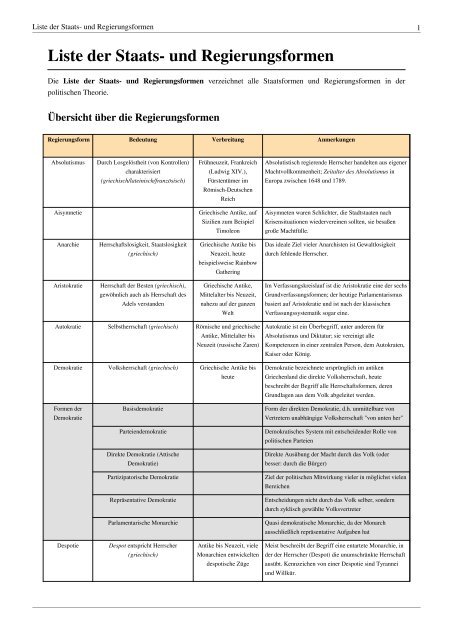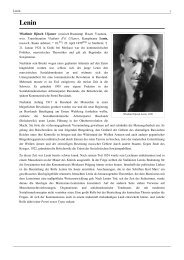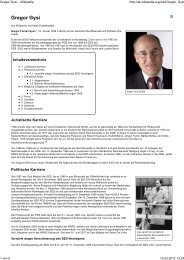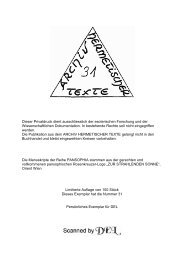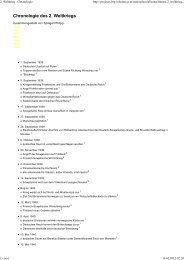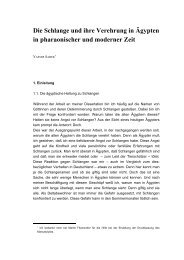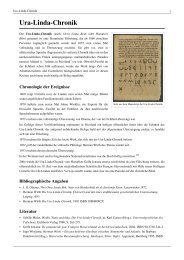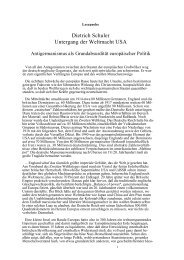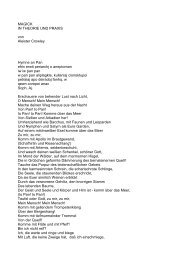Liste der Staats- und Regierungsformen - Ura-linda.de
Liste der Staats- und Regierungsformen - Ura-linda.de
Liste der Staats- und Regierungsformen - Ura-linda.de
Create successful ePaper yourself
Turn your PDF publications into a flip-book with our unique Google optimized e-Paper software.
<strong>Liste</strong> <strong><strong>de</strong>r</strong> <strong>Staats</strong>- <strong>und</strong> <strong>Regierungsformen</strong> 1<strong>Liste</strong> <strong><strong>de</strong>r</strong> <strong>Staats</strong>- <strong>und</strong> <strong>Regierungsformen</strong>Die <strong>Liste</strong> <strong><strong>de</strong>r</strong> <strong>Staats</strong>- <strong>und</strong> <strong>Regierungsformen</strong> verzeichnet alle <strong>Staats</strong>formen <strong>und</strong> <strong>Regierungsformen</strong> in <strong><strong>de</strong>r</strong>politischen Theorie.Übersicht über die <strong>Regierungsformen</strong>Regierungsform Be<strong>de</strong>utung Verbreitung AnmerkungenAbsolutismusDurch Losgelöstheit (von Kontrollen)charakterisiert(griechisch/lateinisch/französisch)Frühneuzeit, Frankreich(Ludwig XIV.),Fürstentümer imRömisch-DeutschenReichAbsolutistisch regieren<strong>de</strong> Herrscher han<strong>de</strong>lten aus eigenerMachtvollkommenheit; Zeitalter <strong>de</strong>s Absolutismus inEuropa zwischen 1648 <strong>und</strong> 1789.AisymnetieGriechische Antike, aufSizilien zum BeispielTimoleonAisymneten waren Schlichter, die Stadtstaaten nachKrisensituationen wie<strong><strong>de</strong>r</strong>vereinen sollten, sie besaßengroße Machtfülle.AnarchieHerrschaftslosigkeit, <strong>Staats</strong>losigkeit(griechisch)Griechische Antike bisNeuzeit, heutebeispielsweise RainbowGatheringDas i<strong>de</strong>ale Ziel vieler Anarchisten ist Gewaltlosigkeitdurch fehlen<strong>de</strong> Herrscher.AristokratieHerrschaft <strong><strong>de</strong>r</strong> Besten (griechisch),gewöhnlich auch als Herrschaft <strong>de</strong>sA<strong>de</strong>ls verstan<strong>de</strong>nGriechische Antike,Mittelalter bis Neuzeit,nahezu auf <strong><strong>de</strong>r</strong> ganzenWeltIm Verfassungskreislauf ist die Aristokratie eine <strong><strong>de</strong>r</strong> sechsGr<strong>und</strong>verfassungsformen; <strong><strong>de</strong>r</strong> heutige Parlamentarismusbasiert auf Aristokratie <strong>und</strong> ist nach <strong><strong>de</strong>r</strong> klassischenVerfassungssystematik sogar eine.Autokratie Selbstherrschaft (griechisch) Römische <strong>und</strong> griechischeAntike, Mittelalter bisNeuzeit (russische Zaren)Demokratie Volksherrschaft (griechisch) Griechische Antike bisheuteAutokratie ist ein Überbegriff, unter an<strong><strong>de</strong>r</strong>em fürAbsolutismus <strong>und</strong> Diktatur; sie vereinigt alleKompetenzen in einer zentralen Person, <strong>de</strong>m Autokraten,Kaiser o<strong><strong>de</strong>r</strong> König.Demokratie bezeichnete ursprünglich im antikenGriechenland die direkte Volksherrschaft, heutebeschreibt <strong><strong>de</strong>r</strong> Begriff alle Herrschaftsformen, <strong><strong>de</strong>r</strong>enGr<strong>und</strong>lagen aus <strong>de</strong>m Volk abgeleitet wer<strong>de</strong>n.Formen <strong><strong>de</strong>r</strong>DemokratieBasis<strong>de</strong>mokratieForm <strong><strong>de</strong>r</strong> direkten Demokratie, d.h. unmittelbare vonVertretern unabhängige Volksherrschaft "von unten her"Parteien<strong>de</strong>mokratieDemokratisches System mit entschei<strong>de</strong>n<strong><strong>de</strong>r</strong> Rolle vonpolitischen ParteienDirekte Demokratie (AttischeDemokratie)Direkte Ausübung <strong><strong>de</strong>r</strong> Macht durch das Volk (o<strong><strong>de</strong>r</strong>besser: durch die Bürger)Partizipatorische DemokratieZiel <strong><strong>de</strong>r</strong> politischen Mitwirkung vieler in möglichst vielenBereichenRepräsentative DemokratieEntscheidungen nicht durch das Volk selber, son<strong><strong>de</strong>r</strong>ndurch zyklisch gewählte VolksvertreterParlamentarische MonarchieQuasi <strong>de</strong>mokratische Monarchie, da <strong><strong>de</strong>r</strong> Monarchausschließlich repräsentative Aufgaben hatDespotieDespot entspricht Herrscher(griechisch)Antike bis Neuzeit, vieleMonarchien entwickelten<strong>de</strong>spotische ZügeMeist beschreibt <strong><strong>de</strong>r</strong> Begriff eine entartete Monarchie, in<strong><strong>de</strong>r</strong> <strong><strong>de</strong>r</strong> Herrscher (Despot) die unumschränkte Herrschaftausübt. Kennzeichen von einer Despotie sind Tyrannei<strong>und</strong> Willkür.
<strong>Liste</strong> <strong><strong>de</strong>r</strong> <strong>Staats</strong>- <strong>und</strong> <strong>Regierungsformen</strong> 2Diktaturmehrfach sprechen, vorschreiben,befehlen(lateinisch)Römische Antike bisNeuzeit, im 20.Jahrhun<strong><strong>de</strong>r</strong>t zum BeispielAdolf Hitler <strong>und</strong> JosefStalinUrsprünglich war ein (römischer) Diktator ein mitSon<strong><strong>de</strong>r</strong>vollmachten legitimierter Befehlshaben<strong><strong>de</strong>r</strong> überalle Bereiche auf Zeit in Notzeiten. In einer Diktaturregiert ein einzelner Diktator o<strong><strong>de</strong>r</strong> eine kleine Gruppeohne freie Wahlen; (mo<strong><strong>de</strong>r</strong>ne) Diktatoren kommen an<strong><strong>de</strong>r</strong>sals Monarchen nicht durch Erbschaft o<strong><strong>de</strong>r</strong> Wahl an dieMacht, son<strong><strong>de</strong>r</strong>n illegitim, in<strong>de</strong>m sie eine legitime<strong>Staats</strong>form stürzen.Formen <strong><strong>de</strong>r</strong>DiktaturFaschismusSammelbegriff für verschie<strong>de</strong>ne, meist rechtsgerichtete,historische <strong>und</strong> i<strong>de</strong>ologisch-politische Richtungen,darunter <strong><strong>de</strong>r</strong> NationalsozialismusMilitärdiktaturAusübung <strong><strong>de</strong>r</strong> Regierung durch ein militärisches SystemDiktatur <strong>de</strong>s ProletariatsPolitische Herrschaft speziell <strong><strong>de</strong>r</strong> ArbeiterklasseDoppelherrschaft(Dyarchie)Altertum bis NeuzeitEine Doppelherrschaft kann sowohl eine Republik alsauch eine Monarchie sein, wenn zwei gleich berechtigteHerrscher sich die Macht teilen.Epistokratie Herrschaft <strong><strong>de</strong>r</strong> Wissen<strong>de</strong>n (griechisch) Griechische Antike Platon, bekanntester Verteidiger <strong><strong>de</strong>r</strong> Epistokratie, wardavon überzeugt, dass nur eine Vereinigung von Macht<strong>und</strong> Wissen das Elend been<strong>de</strong>n könne.Feudalismus Feudum (lateinisch) entspricht Lehen Europäisches Mittelalter<strong>und</strong> Frühe NeuzeitGerontokratie Herrschaft <strong><strong>de</strong>r</strong> Alten (griechisch) Griechische Antike bisheute (Saudi-Arabien)Das Lehnswesen, im Frühmittelalter entstan<strong>de</strong>n, war imeuropäischen Mittelalter die vorwiegen<strong>de</strong>Gesellschaftsform, die auf einem gegenseitigen Treue<strong>und</strong>Fürsorgeverhältnis von Lehnsherrn <strong>und</strong> Lehnsmannberuht.Gesellschaftliche Verfassung, in <strong><strong>de</strong>r</strong> ein Rat <strong><strong>de</strong>r</strong> Altenentschei<strong>de</strong>t; <strong><strong>de</strong>r</strong> Begriff Gerontokrat wird heute ehernegativ verwen<strong>de</strong>t, da er unterstellt, dass dieMachtposition auf das Alter zurückgeht.Gynaikokratie Herrschaft <strong><strong>de</strong>r</strong> Frauen (griechisch) Neuzeit (Minangkabau) Die Gynaikokratie ist eine 1861 entwickelte Theorie, dieheute allerdings verworfen ist.KleptokratieHerrschaft <strong><strong>de</strong>r</strong> Plün<strong><strong>de</strong>r</strong>er,Diebesherrschaft (griechisch)Neuzeit (Zaire,Philippinen)Als Kleptokratie wird eine <strong>Staats</strong>form bezeichnet, die <strong>de</strong>nHerrschen<strong>de</strong>n willkürliche Verfügungsgewalt über Besitz<strong>und</strong> Einkünfte <strong><strong>de</strong>r</strong> Beherrschten gewährt.Kommunismuscommunis (lateinisch) entsprichtgemeinsamNeuzeitDer Kommunismus hat das politische Ziel einerklassenlosen Gesellschaft, in <strong><strong>de</strong>r</strong> das Sozialprodukt allenMenschen gleichermaßen zugänglich ist.Monarchie Herrschaft <strong>de</strong>s Einen(griechisch) Antike bis heute Die <strong>Staats</strong>gewalt ist gr<strong>und</strong>sätzlich in einer Person an <strong><strong>de</strong>r</strong>Spitze konzentriert (nicht notwendigerweise zentralisiert),welche aufgr<strong>und</strong> ihrer Geburt o<strong><strong>de</strong>r</strong>/<strong>und</strong> auf Lebenszeitnach tradierten Riten bestimmt ist <strong>und</strong> legitimerweisenicht ihres Amtes enthoben wer<strong>de</strong>n kann.MeritokratieHerrschaft <strong><strong>de</strong>r</strong> Verdienstvollen(lateinisch/griechisch)Antike bis NeuzeitEine Regierungsform, bei <strong><strong>de</strong>r</strong> Amtsträger aufgr<strong>und</strong> ihrerLeistung o<strong><strong>de</strong>r</strong> ihres Verdienstes ausgewählt wer<strong>de</strong>n, damites keinen Machtmissbrauch gibt.Ochlokratie Herrschaft <strong>de</strong>s Pöbels (griechisch) <strong>Staats</strong>theorie <strong><strong>de</strong>r</strong>griechischen Antike,tatsächliche Einordnungist umstritten.Herrschaft <strong><strong>de</strong>r</strong> Masse, <strong>de</strong>s ungezügelten Pöbels.Oligarchie Herrschaft <strong><strong>de</strong>r</strong> Wenigen (griechisch) Antike bis heute Dabei han<strong>de</strong>lt es sich um die Herrschaft einer faktischelitären kleinen Gruppe <strong><strong>de</strong>r</strong> Bevölkerung allein aufgr<strong>und</strong>ihres Vermögens <strong>und</strong> allein ihrer selbst zugute.
<strong>Liste</strong> <strong><strong>de</strong>r</strong> <strong>Staats</strong>- <strong>und</strong> <strong>Regierungsformen</strong> 3Plutokratie Herrschaft <strong>de</strong>s Gel<strong>de</strong>s (griechisch) Antike bis heute Die Plutokratie o<strong><strong>de</strong>r</strong> Plutarchie ist eine <strong>Staats</strong>form, in <strong><strong>de</strong>r</strong>die Herrschaft durch Vermögen legitimiert wird, also dieHerrschaft <strong>de</strong>s Gel<strong>de</strong>s (auch „Gelda<strong>de</strong>l“ genannt).Politische Rechte wer<strong>de</strong>n anhand <strong>de</strong>s Einkommensvergeben (z. B. über das Zensuswahlrecht).Militärregierung(Stratokratie)Herrschaft <strong>de</strong>s Heeres,Militärregierung (griechisch)Antike bis Neuzeit(Birma)In einer Militärregierung geht die politische Gewalt direktvom Militär aus; reine Militärregierungen sind allerdingsselten.Theokratie Gottesherrschaft (griechisch) Antike bis heute(Islamische Republik Iran,Vatikanstadt)Die <strong>Staats</strong>gewalt ist allein religiös legitimiert, dieHerrschaft wird von einer von <strong>de</strong>n Anhängern als göttlicherwählt Angesehenen Einzelnen (Prophet, Gottkönig)o<strong><strong>de</strong>r</strong> einer Gruppe (Priester) nach religiösen Prinzipien<strong>und</strong> Regeln ausgeübt.TimokratieHerrschaft <strong><strong>de</strong>r</strong> Angesehenen(griechisch)Antike (griechische PolisAthen) bis frühe Neuzeit(europäischeFeudalstaaten)Politische Privilegien wer<strong>de</strong>n nach <strong>de</strong>m materiellen Besitz<strong>und</strong> <strong><strong>de</strong>r</strong> daraus abgeleiteten sozialen Stellung vergeben.Verwirklicht wur<strong>de</strong> dies durch ein Zensuswahlrecht <strong>und</strong>ähnliche Ungleichbehandlungen.Tyrannis(Gewalt-)Herrschaft(lydisch/griechisch)beson<strong><strong>de</strong>r</strong>e Form <strong><strong>de</strong>r</strong>Alleinherrschaft <strong><strong>de</strong>r</strong>griechischen Poleiszwischen 600 <strong>und</strong> 200v.Chr.Der Tyrann hat die vorherige Regierung gewaltsamgestürzt, sei es eigennützig o<strong><strong>de</strong>r</strong> zugunsten bestimmterzuvor benachteiligter sozialer Gruppen. Er wird alsillegitim (d.h. nicht vom göttlichen Gesetz gestützt)angesehen <strong>und</strong> en<strong>de</strong>te häufig so wie die von ihm gestürzteRegierung.Übersicht über die <strong>Staats</strong>formen<strong>Staats</strong>form Be<strong>de</strong>utung Verbreitung AnmerkungenFormen <strong><strong>de</strong>r</strong>MonarchieAbsolute MonarchieErbmonarchieKonstitutionelleMonarchieParlamentarischeMonarchieStändische MonarchieWahlmonarchieSiehe AbsolutismusEine Erbmonarchie bezeichnet eine Monarchie, in <strong><strong>de</strong>r</strong> die Thronfolge durchdie Nachkommen <strong>de</strong>s Monarchen eingenommen wird.Die Macht <strong>de</strong>s Monarchen ist durch eine Verfassung weniger o<strong><strong>de</strong>r</strong> mehrbeeinträchtigt, er kann nicht absolut herrschen.Quasi <strong>de</strong>mokratische Monarchie, da <strong><strong>de</strong>r</strong> Monarch ausschließlich repräsentativeAufgaben hatGlie<strong><strong>de</strong>r</strong>ung <strong>de</strong>s Volkes in mehrere Stän<strong>de</strong>Der Monarch wird nicht durch die Erbfolge, son<strong><strong>de</strong>r</strong>n durch eine WahlbestimmtNeopatrimonialismusvor allem Neuzeit(Afrika)Mischform aus klassisch patrimonialer <strong>und</strong> legal-rationaler Herrschaft;zwischen Demokratie <strong>und</strong> AutokratieRepublikÖffentlicheAngelegenheit(lateinisch)Römische Antikebis heute<strong>Staats</strong>form, die sich am Gemeinwohl orientiert, gilt seit <strong><strong>de</strong>r</strong> FranzösischenRevolution als Gegenstück zur Monarchie; geht oft mit <strong><strong>de</strong>r</strong> Demokratie einher,muss aber nicht (die Römische Republik war beispielsweise nicht<strong>de</strong>mokratisch; parlamentarische Monarchien sind <strong>de</strong>mokratisch, aber keineRepubliken).
<strong>Liste</strong> <strong><strong>de</strong>r</strong> <strong>Staats</strong>- <strong>und</strong> <strong>Regierungsformen</strong> 4Formen <strong><strong>de</strong>r</strong> Republik A<strong>de</strong>lsrepublik In Polen <strong>und</strong> Venedig benutzte Form <strong><strong>de</strong>r</strong> Republik (Wahlmonarchie mit<strong>de</strong>mokratischer Beteiligung <strong>de</strong>s A<strong>de</strong>ls)B<strong>und</strong>esrepublikIslamische RepublikPräsidialrepublikRäterepublikSemipräsi<strong>de</strong>ntiellesRegierungssystemVolksrepublikSynarchie Begriff seit 19.Jahrhun<strong><strong>de</strong>r</strong>tFö<strong><strong>de</strong>r</strong>ale Republik, B<strong>und</strong> mehrerer teilsouveräner Gliedstaaten.Bezeichnung für Staaten, die teilweise nach islamischen Prinzipien regiertwer<strong>de</strong>n.Republik, in <strong><strong>de</strong>r</strong> <strong><strong>de</strong>r</strong> Präsi<strong>de</strong>nt sowohl <strong>Staats</strong>oberhaupt als auchRegierungschef ist.Herrschaft wird über vom Volk direkt gewählte Räte ausgeübt.Ursprünglich Begriff für das politische System Frankreichs während <strong><strong>de</strong>r</strong>Fünften Republik, heute auch auf an<strong><strong>de</strong>r</strong>e Systeme angewandtSelbstbezeichnung, meist für Ein-Parteien-Herrschaften, bei <strong>de</strong>nen einekommunistische Partei autokratisch regiertHerrschaftsform, bei <strong><strong>de</strong>r</strong> die Regierung gleichzeitig von vielen Menschenausgeführt wird; viele Verschwörungstheorien sehen in Synarchien„Weltregierungen“ wie zum Beispiel die Freimaurer o<strong><strong>de</strong>r</strong> <strong>de</strong>nIlluminatenor<strong>de</strong>n.TheokratieGottesherrschaft,Gottesstaat(griechisch)Altertum,Mittelalter bisNeuzeitHerrschaftsform, bei <strong><strong>de</strong>r</strong> <strong><strong>de</strong>r</strong> Herrschen<strong>de</strong> von seinen Anhängern als göttlicherwählte Person verehrt wird <strong>und</strong> seine Macht allein religiös legitimiert wirdTotalitarismusPrägung <strong>de</strong>sBegriffes im 20.Jahrhun<strong><strong>de</strong>r</strong>tEine Form <strong><strong>de</strong>r</strong> Selbstherrschaft, die versucht, <strong>de</strong>n ganzen Menschenumzuformen bzw. einen "neuen Menschen" zu schaffenTyrannis griechisch VorwiegendgriechischeAntikeAlleinherrschaft, <strong><strong>de</strong>r</strong> Herrscher kann nach Aristoteles absolut regieren
Quelle(n) <strong>und</strong> Bearbeiter <strong>de</strong>s/<strong><strong>de</strong>r</strong> Artikel(s) 5Quelle(n) <strong>und</strong> Bearbeiter <strong>de</strong>s/<strong><strong>de</strong>r</strong> Artikel(s)<strong>Liste</strong> <strong><strong>de</strong>r</strong> <strong>Staats</strong>- <strong>und</strong> <strong>Regierungsformen</strong> Quelle: http://<strong>de</strong>.wikipedia.org/w/in<strong>de</strong>x.php?oldid=95533580 Bearbeiter: Ai24, Aka, Ana al'ain, Asakura Akira, Avron, BJ Axel, Bosper, C.Löser,Carsten Wolfram, Celph titled, Claus Miczka, DL5MDA, Doclecter, DonLeone, Dr. Manuel, EUBürger, Glorfin<strong>de</strong>l Goldscheitel, Gugganij, Hammermatz, Harro von Wuff, He3nry, JCIV, JE,Jergen, Jrrtolkien, Kh80, KingLion, Leonce49, Liberal Freemason, Lofor, Lung, Mannerheim, Mathias Schindler, Mikue, Morszeck, Normalo, POY, Patrick Hanft, Pittimann, Polarlys,ProloSozz, Regi51, Revvar, Robert Roessler, Robert Zenz, Schaetzer, Senbat, ShuregaelJrein, Southpark, Srbauer, Themistokles1984, Thommess, Tobias dahin<strong>de</strong>n, TobiasKlaus, Trolinus, Tsor,Tsui, Varus, Wikinger86, Xjs, Zaphiro, Zickzack, Zoris Trömm, Дн, €pa, 113 anonyme BearbeitungenLizenzWichtiger Hinweis zu <strong>de</strong>n LizenzenDie nachfolgen<strong>de</strong>n Lizenzen bezieht sich auf <strong>de</strong>n Artikeltext. Im Artikel gezeigte Bil<strong><strong>de</strong>r</strong> <strong>und</strong> Grafiken können unter einer an<strong><strong>de</strong>r</strong>en Lizenz stehen sowie von Autoren erstellt wor<strong>de</strong>n sein, die nicht in <strong><strong>de</strong>r</strong> Autorenlisteerscheinen. Durch eine noch vorhan<strong>de</strong>ne technische Einschränkung wer<strong>de</strong>n die Lizenzinformationen für Bil<strong><strong>de</strong>r</strong> <strong>und</strong> Grafiken daher nicht angezeigt. An <strong><strong>de</strong>r</strong> Behebung dieser Einschränkung wird gearbeitet.Das PDF ist daher nur für <strong>de</strong>n privaten Gebrauch bestimmt. Eine Weiterverbreitung kann eine Urheberrechtsverletzung be<strong>de</strong>uten.Creative Commons Attribution-ShareAlike 3.0 Unported - DeedDiese "Commons Deed" ist lediglich eine vereinfachte Zusammenfassung <strong>de</strong>s rechtsverbindlichen Lizenzvertrages (http:/ / <strong>de</strong>. wikipedia. org/ wiki/ Wikipedia:Lizenzbestimmungen_Commons_Attribution-ShareAlike_3. 0_Unported)in allgemeinverständlicher Sprache.Sie dürfen:• das Werk bzw. <strong>de</strong>n Inhalt vervielfältigen, verbreiten <strong>und</strong> öffentlich zugänglich machen• Abwandlungen <strong>und</strong> Bearbeitungen <strong>de</strong>s Werkes bzw. Inhaltes anfertigenZu <strong>de</strong>n folgen<strong>de</strong>n Bedingungen:• Namensnennung — Sie müssen <strong>de</strong>n Namen <strong>de</strong>s Autors/Rechteinhabers in <strong><strong>de</strong>r</strong> von ihm festgelegten Weise nennen.• Weitergabe unter gleichen Bedingungen — Wenn Sie das lizenzierte Werk bzw. <strong>de</strong>n lizenzierten Inhalt bearbeiten, abwan<strong>de</strong>ln o<strong><strong>de</strong>r</strong> in an<strong><strong>de</strong>r</strong>er Weise erkennbar als Gr<strong>und</strong>lage für eigenes Schaffen verwen<strong>de</strong>n, dürfen Sie diedaraufhin neu entstan<strong>de</strong>nen Werke bzw. Inhalte nur unter Verwendung von Lizenzbedingungen weitergeben, die mit <strong>de</strong>nen dieses Lizenzvertrages i<strong>de</strong>ntisch, vergleichbar o<strong><strong>de</strong>r</strong> kompatibel sind.Wobei gilt:• Verzichtserklärung — Je<strong>de</strong> <strong><strong>de</strong>r</strong> vorgenannten Bedingungen kann aufgehoben wer<strong>de</strong>n, sofern Sie die ausdrückliche Einwilligung <strong>de</strong>s Rechteinhabers dazu erhalten.• Sonstige Rechte — Die Lizenz hat keinerlei Einfluss auf die folgen<strong>de</strong>n Rechte:• Die gesetzlichen Schranken <strong>de</strong>s Urheberrechts <strong>und</strong> sonstigen Befugnisse zur privaten Nutzung;• Das Urheberpersönlichkeitsrecht <strong>de</strong>s Rechteinhabers;• Rechte an<strong><strong>de</strong>r</strong>er Personen, entwe<strong><strong>de</strong>r</strong> am Lizenzgegenstand selber o<strong><strong>de</strong>r</strong> bezüglich seiner Verwendung, zum Beispiel Persönlichkeitsrechte abgebil<strong>de</strong>ter Personen.• Hinweis — Im Falle einer Verbreitung müssen Sie an<strong><strong>de</strong>r</strong>en alle Lizenzbedingungen mitteilen, die für dieses Werk gelten. Am einfachsten ist es, an entsprechen<strong><strong>de</strong>r</strong> Stelle einen Link auf http:/ / creativecommons. org/ licenses/by-sa/ 3. 0/ <strong>de</strong>ed. <strong>de</strong> einzubin<strong>de</strong>n.HaftungsbeschränkungDie „Commons Deed“ ist kein Lizenzvertrag. Sie ist lediglich ein Referenztext, <strong><strong>de</strong>r</strong> <strong>de</strong>n zugr<strong>und</strong>eliegen<strong>de</strong>n Lizenzvertrag übersichtlich <strong>und</strong> in allgemeinverständlicher Sprache, aber auch stark vereinfacht wie<strong><strong>de</strong>r</strong>gibt. Die Deed selbstentfaltet keine juristische Wirkung <strong>und</strong> erscheint im eigentlichen Lizenzvertrag nicht.GNU Free Documentation LicenseVersion 1.2, November 2002Copyright (C) 2000,2001,2002 Free Software Fo<strong>und</strong>ation, Inc.51 Franklin St, Fifth Floor, Boston, MA 02110-1301 USAEveryone is permitted to copy and distribute verbatim copiesof this license document, but changing it is not allowed.0. PREAMBLEThe purpose of this License is to make a manual, textbook, or other functional and useful document "free" in the sense of freedom: to assure everyone the effective freedom to copy and redistribute it, with or without modifying it,either commercially or noncommercially. Secondarily, this License preserves for the author and publisher a way to get credit for their work, while not being consi<strong><strong>de</strong>r</strong>ed responsible for modifications ma<strong>de</strong> by others.This License is a kind of "copyleft", which means that <strong><strong>de</strong>r</strong>ivative works of the document must themselves be free in the same sense. It complements the GNU General Public License, which is a copyleft license <strong>de</strong>signed for freesoftware.We have <strong>de</strong>signed this License in or<strong><strong>de</strong>r</strong> to use it for manuals for free software, because free software needs free documentation: a free program should come with manuals providing the same freedoms that the software does. But thisLicense is not limited to software manuals; it can be used for any textual work, regardless of subject matter or whether it is published as a printed book. We recommend this License principally for works whose purpose is instruction orreference.1. APPLICABILITY AND DEFINITIONSThis License applies to any manual or other work, in any medium, that contains a notice placed by the copyright hol<strong><strong>de</strong>r</strong> saying it can be distributed un<strong><strong>de</strong>r</strong> the terms of this License. Such a notice grants a world-wi<strong>de</strong>, royalty-freelicense, unlimited in duration, to use that work un<strong><strong>de</strong>r</strong> the conditions stated herein. The "Document", below, refers to any such manual or work. Any member of the public is a licensee, and is addressed as "you". You accept the licenseif you copy, modify or distribute the work in a way requiring permission un<strong><strong>de</strong>r</strong> copyright law.A "Modified Version" of the Document means any work containing the Document or a portion of it, either copied verbatim, or with modifications and/or translated into another language.A "Secondary Section" is a named appendix or a front-matter section of the Document that <strong>de</strong>als exclusively with the relationship of the publishers or authors of the Document to the Document's overall subject (or to related matters)and contains nothing that could fall directly within that overall subject. (Thus, if the Document is in part a textbook of mathematics, a Secondary Section may not explain any mathematics.) The relationship could be a matter ofhistorical connection with the subject or with related matters, or of legal, commercial, philosophical, ethical or political position regarding them.The "Invariant Sections" are certain Secondary Sections whose titles are <strong>de</strong>signated, as being those of Invariant Sections, in the notice that says that the Document is released un<strong><strong>de</strong>r</strong> this License. If a section does not fit the above<strong>de</strong>finition of Secondary then it is not allowed to be <strong>de</strong>signated as Invariant. The Document may contain zero Invariant Sections. If the Document does not i<strong>de</strong>ntify any Invariant Sections then there are none.The "Cover Texts" are certain short passages of text that are listed, as Front-Cover Texts or Back-Cover Texts, in the notice that says that the Document is released un<strong><strong>de</strong>r</strong> this License. A Front-Cover Text may be at most 5 words, and aBack-Cover Text may be at most 25 words.A "Transparent" copy of the Document means a machine-readable copy, represented in a format whose specification is available to the general public, that is suitable for revising the document straightforwardly with generic text editorsor (for images composed of pixels) generic paint programs or (for drawings) some wi<strong>de</strong>ly available drawing editor, and that is suitable for input to text formatters or for automatic translation to a variety of formats suitable for input totext formatters. A copy ma<strong>de</strong> in an otherwise Transparent file format whose markup, or absence of markup, has been arranged to thwart or discourage subsequent modification by rea<strong><strong>de</strong>r</strong>s is not Transparent. An image format is notTransparent if used for any substantial amount of text. A copy that is not "Transparent" is called "Opaque".Examples of suitable formats for Transparent copies inclu<strong>de</strong> plain ASCII without markup, Texinfo input format, LaTeX input format, SGML or XML using a publicly available DTD, and standard-conforming simple HTML,PostScript or PDF <strong>de</strong>signed for human modification. Examples of transparent image formats inclu<strong>de</strong> PNG, XCF and JPG. Opaque formats inclu<strong>de</strong> proprietary formats that can be read and edited only by proprietary word processors,SGML or XML for which the DTD and/or processing tools are not generally available, and the machine-generated HTML, PostScript or PDF produced by some word processors for output purposes only.The "Title Page" means, for a printed book, the title page itself, plus such following pages as are nee<strong>de</strong>d to hold, legibly, the material this License requires to appear in the title page. For works in formats which do not have any titlepage as such, "Title Page" means the text near the most prominent appearance of the work's title, preceding the beginning of the body of the text.A section "Entitled XYZ" means a named subunit of the Document whose title either is precisely XYZ or contains XYZ in parentheses following text that translates XYZ in another language. (Here XYZ stands for a specific sectionname mentioned below, such as "Acknowledgements", "Dedications", "Endorsements", or "History".) To "Preserve the Title" of such a section when you modify the Document means that it remains a section "Entitled XYZ" accordingto this <strong>de</strong>finition.The Document may inclu<strong>de</strong> Warranty Disclaimers next to the notice which states that this License applies to the Document. These Warranty Disclaimers are consi<strong><strong>de</strong>r</strong>ed to be inclu<strong>de</strong>d by reference in this License, but only as regardsdisclaiming warranties: any other implication that these Warranty Disclaimers may have is void and has no effect on the meaning of this License.2. VERBATIM COPYINGYou may copy and distribute the Document in any medium, either commercially or noncommercially, provi<strong>de</strong>d that this License, the copyright notices, and the license notice saying this License applies to the Document are reproducedin all copies, and that you add no other conditions whatsoever to those of this License. You may not use technical measures to obstruct or control the reading or further copying of the copies you make or distribute. However, you mayaccept compensation in exchange for copies. If you distribute a large enough number of copies you must also follow the conditions in section 3.You may also lend copies, un<strong><strong>de</strong>r</strong> the same conditions stated above, and you may publicly display copies.3. COPYING IN QUANTITYIf you publish printed copies (or copies in media that commonly have printed covers) of the Document, numbering more than 100, and the Document's license notice requires Cover Texts, you must enclose the copies in covers thatcarry, clearly and legibly, all these Cover Texts: Front-Cover Texts on the front cover, and Back-Cover Texts on the back cover. Both covers must also clearly and legibly i<strong>de</strong>ntify you as the publisher of these copies. The front covermust present the full title with all words of the title equally prominent and visible. You may add other material on the covers in addition. Copying with changes limited to the covers, as long as they preserve the title of the Documentand satisfy these conditions, can be treated as verbatim copying in other respects.If the required texts for either cover are too voluminous to fit legibly, you should put the first ones listed (as many as fit reasonably) on the actual cover, and continue the rest onto adjacent pages.If you publish or distribute Opaque copies of the Document numbering more than 100, you must either inclu<strong>de</strong> a machine-readable Transparent copy along with each Opaque copy, or state in or with each Opaque copy acomputer-network location from which the general network-using public has access to download using public-standard network protocols a complete Transparent copy of the Document, free of ad<strong>de</strong>d material. If you use the latteroption, you must take reasonably pru<strong>de</strong>nt steps, when you begin distribution of Opaque copies in quantity, to ensure that this Transparent copy will remain thus accessible at the stated location until at least one year after the last timeyou distribute an Opaque copy (directly or through your agents or retailers) of that edition to the public.It is requested, but not required, that you contact the authors of the Document well before redistributing any large number of copies, to give them a chance to provi<strong>de</strong> you with an updated version of the Document.4. MODIFICATIONSYou may copy and distribute a Modified Version of the Document un<strong><strong>de</strong>r</strong> the conditions of sections 2 and 3 above, provi<strong>de</strong>d that you release the Modified Version un<strong><strong>de</strong>r</strong> precisely this License, with the Modified Version filling the roleof the Document, thus licensing distribution and modification of the Modified Version to whoever possesses a copy of it. In addition, you must do these things in the Modified Version:• A. Use in the Title Page (and on the covers, if any) a title distinct from that of the Document, and from those of previous versions (which should, if there were any, be listed in the History section of the Document). You may usethe same title as a previous version if the original publisher of that version gives permission.• B. List on the Title Page, as authors, one or more persons or entities responsible for authorship of the modifications in the Modified Version, together with at least five of the principal authors of the Document (all of its principalauthors, if it has fewer than five), unless they release you from this requirement.• C. State on the Title page the name of the publisher of the Modified Version, as the publisher.• D. Preserve all the copyright notices of the Document.• E. Add an appropriate copyright notice for your modifications adjacent to the other copyright notices.• F. Inclu<strong>de</strong>, immediately after the copyright notices, a license notice giving the public permission to use the Modified Version un<strong><strong>de</strong>r</strong> the terms of this License, in the form shown in the Ad<strong>de</strong>ndum below.• G. Preserve in that license notice the full lists of Invariant Sections and required Cover Texts given in the Document's license notice.• H. Inclu<strong>de</strong> an unaltered copy of this License.• I. Preserve the section Entitled "History", Preserve its Title, and add to it an item stating at least the title, year, new authors, and publisher of the Modified Version as given on the Title Page. If there is no section Entitled"History" in the Document, create one stating the title, year, authors, and publisher of the Document as given on its Title Page, then add an item <strong>de</strong>scribing the Modified Version as stated in the previous sentence.• J. Preserve the network location, if any, given in the Document for public access to a Transparent copy of the Document, and likewise the network locations given in the Document for previous versions it was based on. Thesemay be placed in the "History" section. You may omit a network location for a work that was published at least four years before the Document itself, or if the original publisher of the version it refers to gives permission.• K. For any section Entitled "Acknowledgements" or "Dedications", Preserve the Title of the section, and preserve in the section all the substance and tone of each of the contributor acknowledgements and/or <strong>de</strong>dications giventherein.
Lizenz 6• L. Preserve all the Invariant Sections of the Document, unaltered in their text and in their titles. Section numbers or the equivalent are not consi<strong><strong>de</strong>r</strong>ed part of the section titles.• M. Delete any section Entitled "Endorsements". Such a section may not be inclu<strong>de</strong>d in the Modified Version.• N. Do not retitle any existing section to be Entitled "Endorsements" or to conflict in title with any Invariant Section.• O. Preserve any Warranty Disclaimers.If the Modified Version inclu<strong>de</strong>s new front-matter sections or appendices that qualify as Secondary Sections and contain no material copied from the Document, you may at your option <strong>de</strong>signate some or all of these sections asinvariant. To do this, add their titles to the list of Invariant Sections in the Modified Version's license notice. These titles must be distinct from any other section titles.You may add a section Entitled "Endorsements", provi<strong>de</strong>d it contains nothing but endorsements of your Modified Version by various parties--for example, statements of peer review or that the text has been approved by an organizationas the authoritative <strong>de</strong>finition of a standard.You may add a passage of up to five words as a Front-Cover Text, and a passage of up to 25 words as a Back-Cover Text, to the end of the list of Cover Texts in the Modified Version. Only one passage of Front-Cover Text and one ofBack-Cover Text may be ad<strong>de</strong>d by (or through arrangements ma<strong>de</strong> by) any one entity. If the Document already inclu<strong>de</strong>s a cover text for the same cover, previously ad<strong>de</strong>d by you or by arrangement ma<strong>de</strong> by the same entity you areacting on behalf of, you may not add another; but you may replace the old one, on explicit permission from the previous publisher that ad<strong>de</strong>d the old one.The author(s) and publisher(s) of the Document do not by this License give permission to use their names for publicity for or to assert or imply endorsement of any Modified Version.5. COMBINING DOCUMENTSYou may combine the Document with other documents released un<strong><strong>de</strong>r</strong> this License, un<strong><strong>de</strong>r</strong> the terms <strong>de</strong>fined in section 4 above for modified versions, provi<strong>de</strong>d that you inclu<strong>de</strong> in the combination all of the Invariant Sections of all ofthe original documents, unmodified, and list them all as Invariant Sections of your combined work in its license notice, and that you preserve all their Warranty Disclaimers.The combined work need only contain one copy of this License, and multiple i<strong>de</strong>ntical Invariant Sections may be replaced with a single copy. If there are multiple Invariant Sections with the same name but different contents, make thetitle of each such section unique by adding at the end of it, in parentheses, the name of the original author or publisher of that section if known, or else a unique number. Make the same adjustment to the section titles in the list ofInvariant Sections in the license notice of the combined work.In the combination, you must combine any sections Entitled "History" in the various original documents, forming one section Entitled "History"; likewise combine any sections Entitled "Acknowledgements", and any sections Entitled"Dedications". You must <strong>de</strong>lete all sections Entitled "Endorsements".6. COLLECTIONS OF DOCUMENTSYou may make a collection consisting of the Document and other documents released un<strong><strong>de</strong>r</strong> this License, and replace the individual copies of this License in the various documents with a single copy that is inclu<strong>de</strong>d in the collection,provi<strong>de</strong>d that you follow the rules of this License for verbatim copying of each of the documents in all other respects.You may extract a single document from such a collection, and distribute it individually un<strong><strong>de</strong>r</strong> this License, provi<strong>de</strong>d you insert a copy of this License into the extracted document, and follow this License in all other respects regardingverbatim copying of that document.7. AGGREGATION WITH INDEPENDENT WORKSA compilation of the Document or its <strong><strong>de</strong>r</strong>ivatives with other separate and in<strong>de</strong>pen<strong>de</strong>nt documents or works, in or on a volume of a storage or distribution medium, is called an "aggregate" if the copyright resulting from the compilationis not used to limit the legal rights of the compilation's users beyond what the individual works permit. When the Document is inclu<strong>de</strong>d in an aggregate, this License does not apply to the other works in the aggregate which are notthemselves <strong><strong>de</strong>r</strong>ivative works of the Document.If the Cover Text requirement of section 3 is applicable to these copies of the Document, then if the Document is less than one half of the entire aggregate, the Document's Cover Texts may be placed on covers that bracket theDocument within the aggregate, or the electronic equivalent of covers if the Document is in electronic form. Otherwise they must appear on printed covers that bracket the whole aggregate.8. TRANSLATIONTranslation is consi<strong><strong>de</strong>r</strong>ed a kind of modification, so you may distribute translations of the Document un<strong><strong>de</strong>r</strong> the terms of section 4. Replacing Invariant Sections with translations requires special permission from their copyright hol<strong><strong>de</strong>r</strong>s,but you may inclu<strong>de</strong> translations of some or all Invariant Sections in addition to the original versions of these Invariant Sections. You may inclu<strong>de</strong> a translation of this License, and all the license notices in the Document, and anyWarranty Disclaimers, provi<strong>de</strong>d that you also inclu<strong>de</strong> the original English version of this License and the original versions of those notices and disclaimers. In case of a disagreement between the translation and the original version ofthis License or a notice or disclaimer, the original version will prevail.If a section in the Document is Entitled "Acknowledgements", "Dedications", or "History", the requirement (section 4) to Preserve its Title (section 1) will typically require changing the actual title.9. TERMINATIONYou may not copy, modify, sublicense, or distribute the Document except as expressly provi<strong>de</strong>d for un<strong><strong>de</strong>r</strong> this License. Any other attempt to copy, modify, sublicense or distribute the Document is void, and will automatically terminateyour rights un<strong><strong>de</strong>r</strong> this License. However, parties who have received copies, or rights, from you un<strong><strong>de</strong>r</strong> this License will not have their licenses terminated so long as such parties remain in full compliance.10. FUTURE REVISIONS OF THIS LICENSEThe Free Software Fo<strong>und</strong>ation may publish new, revised versions of the GNU Free Documentation License from time to time. Such new versions will be similar in spirit to the present version, but may differ in <strong>de</strong>tail to address newproblems or concerns. See http:/ / www. gnu. org/ copyleft/ .Each version of the License is given a distinguishing version number. If the Document specifies that a particular numbered version of this License "or any later version" applies to it, you have the option of following the terms andconditions either of that specified version or of any later version that has been published (not as a draft) by the Free Software Fo<strong>und</strong>ation. If the Document does not specify a version number of this License, you may choose any versionever published (not as a draft) by the Free Software Fo<strong>und</strong>ation.ADDENDUM: How to use this License for your documentsTo use this License in a document you have written, inclu<strong>de</strong> a copy of the License in the document and put the following copyright and license notices just after the title page:Copyright (c) YEAR YOUR NAME.Permission is granted to copy, distribute and/or modify this documentun<strong><strong>de</strong>r</strong> the terms of the GNU Free Documentation License, Version 1.2or any later version published by the Free Software Fo<strong>und</strong>ation;with no Invariant Sections, no Front-Cover Texts, and no Back-Cover Texts.A copy of the license is inclu<strong>de</strong>d in the section entitled"GNU Free Documentation License".If you have Invariant Sections, Front-Cover Texts and Back-Cover Texts, replace the "with...Texts." line with this:with the Invariant Sections being LIST THEIR TITLES, with theFront-Cover Texts being LIST, and with the Back-Cover Texts being LIST.If you have Invariant Sections without Cover Texts, or some other combination of the three, merge those two alternatives to suit the situation.If your document contains nontrivial examples of program co<strong>de</strong>, we recommend releasing these examples in parallel un<strong><strong>de</strong>r</strong> your choice of free software license, such as the GNU General Public License, to permit their use in freesoftware.


